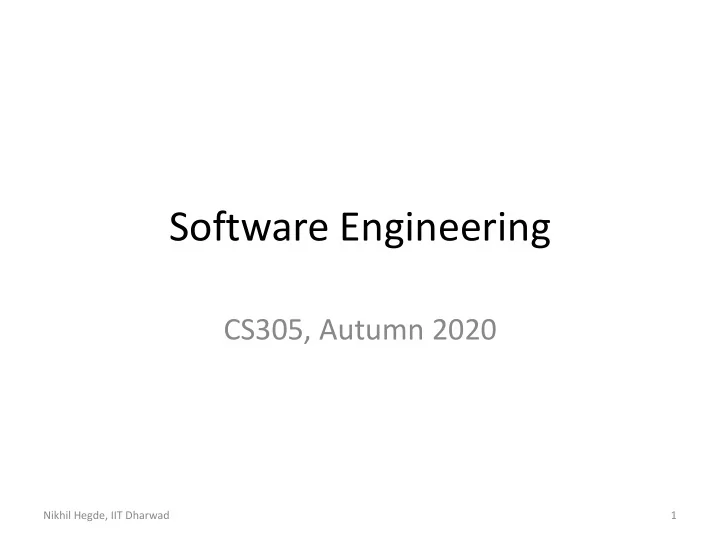

Software Engineering CS305, Autumn 2020 Nikhil Hegde, IIT Dharwad 1
Software Engineering Software + Engineering What is Software? – An abstraction that: • Defines a set of computations • Becomes concrete/useful only in the presence of hardware and context (e.g. human activity) What is Engineering? – Traditionally: “use of scientific principles to design and build machines, structures, and other items” - Wikipedia / Oxford dictionary Nikhil Hegde, IIT Dharwad 2
Why Software Engineering? • Why is it so difficult to build software? • Why is it so difficult to build good software? Software engineering is a fundamental discipline Nikhil Hegde, IIT Dharwad 3
Software Engineering • Systematic study of: – Methodology – Techniques – Tools to build high quality software that is correct and is built in a given time and price budget Nikhil Hegde, IIT Dharwad 4
Lines of Code in Software Software Engineering Individual effort Lines of code: 10 1 10 2 10 3 10 4 10 5 10 6 ………………... Nikhil Hegde, IIT Dharwad 5
Picture of a Crisis 9 Software Projects worth $7M Delivered but not used Not delivered Used after extensive modification Used after changes Used as delivered • $5M / $7M projects either not delivered or never used! Davis A. M. (1990) Software Requirements Analysis & Specification. Prentice-Hall, NJ. Nikhil Hegde, IIT Dharwad 6
Software Processes • Transforming an idea to software is a complex task • Processes help manage the complexity – Break the task into several steps/phases that are: • Systematic • Formal Nikhil Hegde, IIT Dharwad 7
Software Processes • Transforming an idea to software is a complex task • Processes help manage the complexity – Break the task into several steps/phases that are: • Systematic • Formal – E.g. 1) Waterfall model, 2) Evolutionary prototype 3) Unified Software Process, 4) Agile methodology Nikhil Hegde, IIT Dharwad 8
Exercise • How many lines of code (LOC) does an average software developer produce per day? LOC/day: o < 25 o 25-50 o 50-100 o 100-1000 o > 1000 o https://forms.gle/uyCqG6rMrnGavmhz8 Nikhil Hegde, IIT Dharwad 9
Software Phases • Processes are characterized by phases – steps in systematic software development • Software Phases: 1. Requirements / System Engineering 2. Design 3. Implementation 4. Verification and Validation 5. Maintenance Nikhil Hegde, IIT Dharwad 10
Last Class… • What is Software Engineering ? • What lead to Software Engineering as a discipline? – Software boom, Complexity, Failures • Why is it so difficult to build good software? – Correctness, Price and Time constraints • What are different phases or activities of software development? – Ordering of activities Processes – Duration of activities Nikhil Hegde, IIT Dharwad 11
Turning Ideas into Software is complicated! Source: Alex Orso (CS 3300) Nikhil Hegde, IIT Dharwad 12
Today’s Class… • Managing Software Complexity Through Software Development Life Cycle (SDLC) Models / Processes – Waterfall Model – Spiral Model – Evolutionary Prototyping – Rational Unified Process – Agile Methodology • Software Complexity and Programmer Productivity Nikhil Hegde, IIT Dharwad 13
SDLC Activities / Steps – Requirements Engineering • Establish stakeholders’ needs that are to be satisfied by the software • Why Important? – Cost of correcting errors • Grows exponentially as we move to maintenance phase • How to get it right? – Elicit, Analyze, Specify, Validate, Manage - Iterate Nikhil Hegde, IIT Dharwad 14
SDLC Activities / Steps – Design • Translate Requirements to internal structure – Architecture, Interface, Component, Data structure, algorithm Nikhil Hegde, IIT Dharwad 15
SDLC Activities / Steps – Coding • Translate design into software • How to get it right? Keep a tab on.. – Complexity – Diversity – Validation – Standards Nikhil Hegde, IIT Dharwad 16
SDLC Activities / Steps – Verification and Validation • Have we built the right system? - validation • Have we built the system right? – verification • Done at: – Unit, Integration, System levels Nikhil Hegde, IIT Dharwad 17
SDLC Activities / Steps – Maintenance • Deals with handling issues / requests seen after the software is delivered • Corrective – Bug fixes • Perfective – enhancements • Adaptive – environment changes Nikhil Hegde, IIT Dharwad 18
Waterfall Model • Go from one phase to another like a cascading waterfall Software Concept Requirements Analysis Architectural Design Detailed Design Coding and Debugging System Testing – Very old – Pros: Finds errors easily – Cons: Not flexible Nikhil Hegde, IIT Dharwad 19
Spiral Model • Incremental Risk-Oriented Model – Determine Objectives – Identify and Resolve Risks – Develop and Test Software – Plan Next Iteration Iterate… – Cons: Complex, Dependent on Risk Analysis, Requires Specific Expertise – Pros: Risk Reduction, Easy to Enhance, Software Produced Early Nikhil Hegde, IIT Dharwad 20
Evolutionary Prototyping • Evolve an initial prototype based on customer feedback – Start with an initial Prototype – Design and Implement the Prototype – Refine Until Acceptable – Complete and Release – Pros: Immediate Feedback, Helps Requirements Understanding – Cons: Difficult to Plan, Can Deteriorate to Code-and-fix Nikhil Hegde, IIT Dharwad 21
Rational Unified Process • Use Unified Modeling Language (UML) to formally capture the order and duration of different activities – Inception, Elaboration, Construction, Transition Nikhil Hegde, IIT Dharwad 22
Agile • Be more flexible (trading off discipline) in accommodating changes in requirements – Fail, Pass, Refactor Nikhil Hegde, IIT Dharwad 23
Choosing A Model • Requirements Understanding • Expected Lifetime • Risk • Schedule Constraints • Interaction with Customers • Expertise Nikhil Hegde, IIT Dharwad 24
Tools for Software Engineering • Software Complexity vs. Developer Productivity Software Size and Complexity Desired Developer Productivity Developer Productivity • Productivity: – Development : punch cards vs. IDE (Eclipse, Microsoft Visual Studio) – Language: machine code vs. high-level language (e.g. C++, SQL) – Debugging: print statements vs. debuggers (e.g. GDB) – Others: Version control (e.g. Git), Code coverage and verification (e.g. Coverity, GCov) Nikhil Hegde, IIT Dharwad 25
Recommend
More recommend